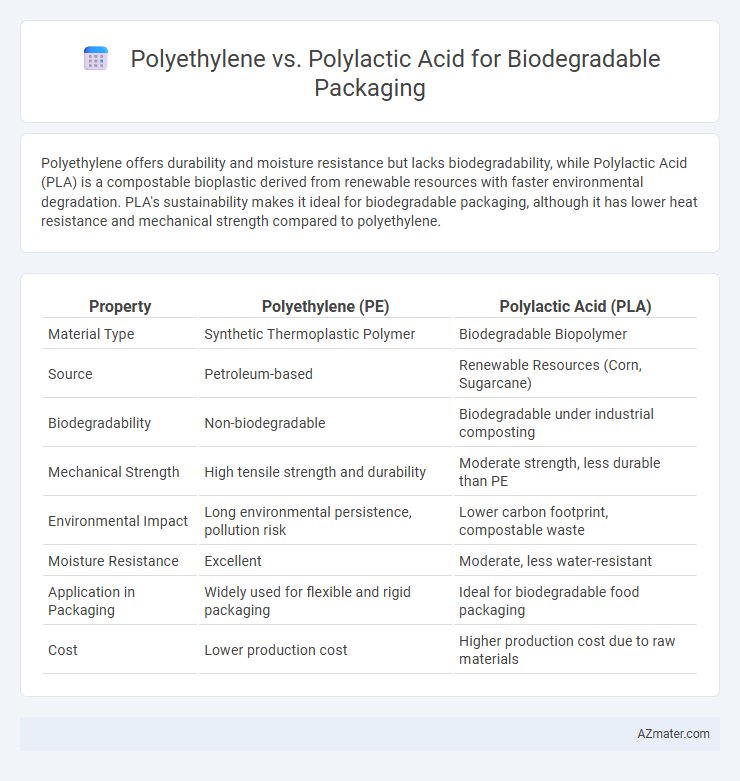Polyethylene offers durability and moisture resistance but lacks biodegradability, while Polylactic Acid (PLA) is a compostable bioplastic derived from renewable resources with faster environmental degradation. PLA's sustainability makes it ideal for biodegradable packaging, although it has lower heat resistance and mechanical strength compared to polyethylene.
Table of Comparison
| Property | Polyethylene (PE) | Polylactic Acid (PLA) |
|---|---|---|
| Material Type | Synthetic Thermoplastic Polymer | Biodegradable Biopolymer |
| Source | Petroleum-based | Renewable Resources (Corn, Sugarcane) |
| Biodegradability | Non-biodegradable | Biodegradable under industrial composting |
| Mechanical Strength | High tensile strength and durability | Moderate strength, less durable than PE |
| Environmental Impact | Long environmental persistence, pollution risk | Lower carbon footprint, compostable waste |
| Moisture Resistance | Excellent | Moderate, less water-resistant |
| Application in Packaging | Widely used for flexible and rigid packaging | Ideal for biodegradable food packaging |
| Cost | Lower production cost | Higher production cost due to raw materials |
Introduction to Biodegradable Packaging
Biodegradable packaging materials are designed to break down naturally through microbial activity, reducing environmental impact and landfill waste. Polyethylene, a conventional plastic derived from petrochemicals, offers durability but lacks biodegradability, contributing to long-term pollution. Polylactic Acid (PLA), made from renewable resources like corn starch or sugarcane, serves as a sustainable alternative with compostable properties suitable for eco-friendly packaging solutions.
What is Polyethylene (PE)?
Polyethylene (PE) is a widely used synthetic polymer derived from petroleum, known for its durability, flexibility, and resistance to moisture and chemicals. It is commonly used in packaging applications but poses environmental challenges due to its non-biodegradable nature and slow decomposition rates in landfills. Despite these drawbacks, PE remains popular in packaging because of its cost-effectiveness and strong protective qualities for food and consumer goods.
What is Polylactic Acid (PLA)?
Polylactic Acid (PLA) is a biodegradable thermoplastic derived from renewable resources such as corn starch or sugarcane, making it an eco-friendly alternative to traditional plastics. PLA offers excellent transparency, rigidity, and compostability, which suits packaging applications requiring sustainability and reduced environmental impact. Unlike polyethylene, PLA decomposes under industrial composting conditions within a few months, contributing to lower landfill waste and greenhouse gas emissions.
Environmental Impact: PE vs PLA
Polyethylene (PE) is a petroleum-based plastic with a low biodegradability rate, contributing significantly to long-term environmental pollution and microplastic accumulation in ecosystems. Polylactic Acid (PLA), derived from renewable resources like corn starch or sugarcane, offers a compostable alternative that breaks down under industrial composting conditions, reducing landfill burden and greenhouse gas emissions. Lifecycle assessments reveal PLA's lower carbon footprint compared to PE, although PLA's biodegradability depends on specific composting infrastructure, highlighting the importance of waste management systems for environmental impact mitigation.
Degradability and Compostability Comparison
Polyethylene (PE) is a widely used plastic known for its durability but exhibits poor biodegradability, persisting in the environment for decades. Polylactic Acid (PLA), derived from renewable resources like corn starch, offers superior compostability, breaking down into water, carbon dioxide, and biomass under industrial composting conditions within 90 to 180 days. Unlike PE, PLA's biodegradability significantly reduces environmental impact by facilitating effective composting and minimizing plastic waste accumulation.
Mechanical Properties and Performance
Polyethylene (PE) offers superior tensile strength and elongation at break, making it highly durable and flexible for packaging applications. Polylactic Acid (PLA), while biodegradable and compostable, exhibits lower impact resistance and higher brittleness compared to PE, limiting its performance under mechanical stress. PLA's rigidity and lower thermal stability present challenges in packaging requiring high mechanical endurance, whereas PE's resilience ensures longer shelf life and protection during transport.
Cost Analysis: Polyethylene vs Polylactic Acid
Polyethylene remains significantly cheaper than polylactic acid for biodegradable packaging, with production costs approximately 30-50% lower due to its widespread availability and established manufacturing processes. Polylactic acid, derived from renewable resources like corn starch, involves higher raw material expenses and more energy-intensive processing methods, driving up its price by 20-40% compared to conventional plastics. Despite higher upfront costs, polylactic acid offers potential long-term economic benefits through regulatory incentives and growing consumer demand for sustainable packaging solutions.
Food Safety and Regulatory Approvals
Polyethylene (PE) is widely used in food packaging due to its excellent barrier properties and FDA approval ensuring food safety compliance, but it is not biodegradable, posing environmental concerns. Polylactic Acid (PLA), derived from renewable resources, offers biodegradability and compostability while meeting FDA standards for food contact materials, though its barrier properties are generally lower than PE's. Regulatory approvals for both materials emphasize stringent migration limits and toxicity assessments, with PLA gaining traction as a sustainable alternative in food packaging sectors prioritizing eco-friendly solutions.
Industrial Applications and Limitations
Polyethylene (PE) dominates industrial packaging due to its durability, moisture resistance, and cost-effectiveness, yet its non-biodegradability poses environmental challenges. Polylactic Acid (PLA), derived from renewable resources, offers biodegradability and compostability, making it suitable for short-lifespan packaging in food and medical industries but suffers from lower mechanical strength and thermal resistance. Industrial adoption of PLA is limited by higher production costs and limited compatibility with existing recycling systems, whereas PE's widespread infrastructure supports mass production and diverse applications despite its environmental impact.
Future Trends in Biodegradable Packaging Materials
Future trends in biodegradable packaging emphasize increased adoption of polylactic acid (PLA) due to its renewable, compostable nature derived from plant sugars, contrasting with conventional petroleum-based polyethylene (PE). Innovations in polymer blending and bio-based additives aim to enhance PLA's mechanical strength and barrier properties to rival polyethylene's durability and moisture resistance. Emerging research prioritizes scalable production methods and lifecycle assessments to balance environmental impact with cost-efficiency, positioning PLA as a leading material in sustainable packaging solutions.

Infographic: Polyethylene vs Polylactic Acid for Biodegradable Packaging
 azmater.com
azmater.com